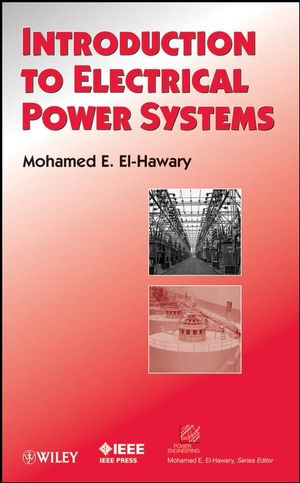Introduction to Electrical Power SystemsISBN: 978-0-470-40863-6
Hardcover
408 pages
October 2008, Wiley-IEEE Press
 This is a Print-on-Demand title. It will be printed specifically to fill your order. Please allow an additional 10-15 days delivery time. The book is not returnable.
|
||||||
Chapter 1: INTRODUCTION.
1.1 A Brief History of Electric Power Systems.
1.2 The Structure of the Power System.
1.3 Outline of the Text.
Chapter 2: BASICS OF ELECTRIC ENERGY SYSTEM THEORY.
2.1 Introduction.
2.2 Concepts of Power in Alternating Current Systems.
2.3 Three-Phase Systems.
2.4 The Per Unit System.
2.5 Electromagnetism and Electromechanical Energy Conversion.
2.6 Permeability and Magnetic Field Intensity.
2.7 Flux Linkages, Induced Voltages, Inductance, and Energy.
2.8 Hysteresis Loop.
2.9 Eddy Current and Core Losses.
2.10 Energy Flow Approach.
2.11 Multiply Excited Systems.
2.12 Doubly Excited Systems.
2.13 Salient-Pole Machines.
2.14 Round or Smooth Air-Gap Machines.
2.15 Machine-Type Classification.
2.16 P-Pole Machines.
2.17 Power System Representation.
Problems.
Chapter 3: POWER GENERATION AND THE SYNCHRONOUS MACHINE.
3.1 Introduction.
3.2 The Synchronous Machine: Preliminaries.
3.3 Synchronous Machine Fields.
3.4 A Simple Equivalent Circuit.
3.5 Principal Steady-State Characteristics.
3.6 Power-Angle Characteristics and the Infinite Bus Concept.
3.7 Accounting for Saliency.
3.8 Salient-Pole Machine Power Angle Characteristics.
Problems.
Chapter 4: THE TRANSFORMER.
4.1 Introduction.
4.2 General Theory of Transformer Operation.
4.3 Transformer Connections.
Problems.
Chapter 5: ELECTRIC POWER TRANSMISSION.
5.1 Introduction.
5.2 Electric Transmission Line Parameters.
5.3 Line Inductance.
5.4 Line Capacitance.
5.5 Two-Port Networks.
5.6 Transmission Line Models.
Problems.
Chapter 6: INDUCTION AND FRACTIONAL HORSEPOWER MOTORS.
6.1 Introduction.
6.2 Three-Phase Induction Motors.
6.3 Torque Relations.
6.4 Classification of Induction Motors.
6.5 Rotating Magnetic Fields in Single-Phase Induction Motors.
6.6 Equivalent Circuits for Single-Phase Induction Motors.
6.7 Power and Torque Relations.
6.8 Starting Single-Phase Induction Motors.
6.9 Single-Phase Induction Motor Types.
Problems.
Chapter 7: FAULTS AND PROTECTION OF ELECTRIC ENERGY SYSTEMS.
7.1 Introduction.
7.2 Transients during a Balanced Fault.
7.3 The Method of Symmetrical Components.
7.4 Sequence Networks.
7.5 Line-to-Ground Fault.
7.6 Double Line-to-Ground Fault.
7.7 Line-to-Line Fault.
7.8 The Balanced Three-Phase Fault.
7.9 System Protection, An Introduction.
7.10 Protective Relays.
7.11 Transformer Protection.
7.12 Transmission Line Protection.
7.13 Impedance-Based Protection Principles.
7.14 Computer Relaying.
Problems.
Chapter 8: THE ENERGY CONTROL CENTER.
8.1 Introduction
8.2 Overview of EMS Functions.
8.3 Power Flow Control
8.4 Power Flow
8.5 Stability Considerations
8.6 Power System State Estimation
8.7 Power System Security
8.8 Contingency Analysis
8.9 Optimal Preventive and Corrective Actions
8.10 Dynamic Security Analysis
Chapter 9: THE PRESENT AND FUTURE OF ELECTRIC ENERGY SYSTEMS.
9.1 Introduction.
9.2 Challenges Facing the System.
9.3 Blackouts and their Impact.
9.4 Mitigating and Coping.
REFERENCES.
INDEX.



